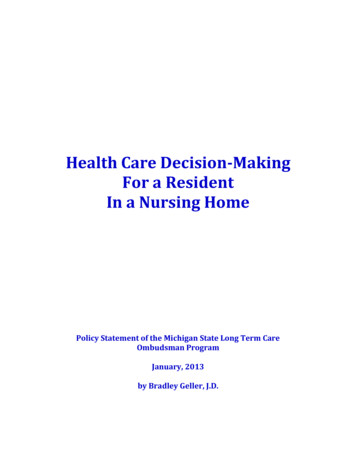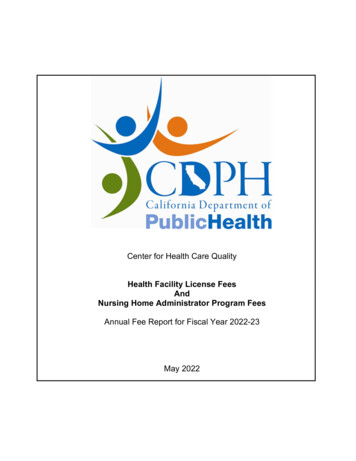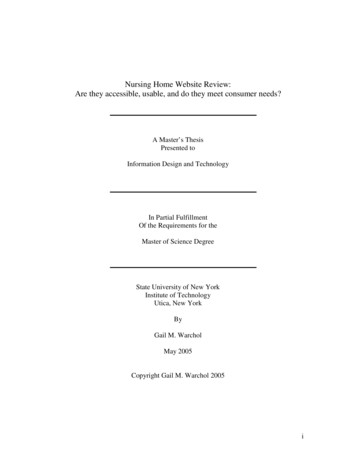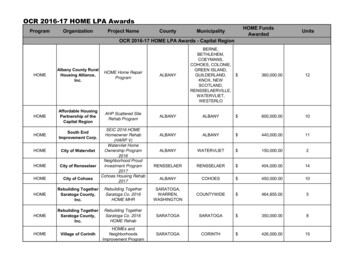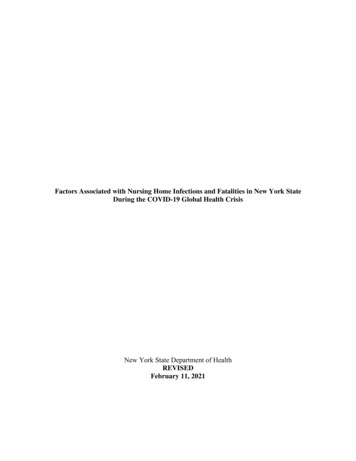
Transcription
Factors Associated with Nursing Home Infections and Fatalities in New York StateDuring the COVID-19 Global Health CrisisNew York State Department of HealthREVISEDFebruary 11, 2021
Table of ContentsExecutive Summary . 3Background . 6I.COVID-19 Staff Illness Contributed to Infections of Nursing Home Residents. 9II.Potential Transmission from Residents with COVID-19 Who Were Admitted tothe Nursing Homes. 16III.Nursing Home Quality Contributing to COVID-19 Resident Exposure . 23IV.Age of the Nursing Home Resident as a Factor for Mortality . 24Conclusion . 25Appendices . 27Appendix A. Nursing Home Facilities, by State . 28Appendix B. Cases and Deaths in Nursing Homes, by State . 31Appendix C. Nursing Home Fatalities as a Percentage of Nursing Home Residents andGeneral Population . 33Addendum (July 17, 2020 Revision) . 34Addendum (February 11, 2021 Revision) .352
Executive SummaryIn an effort to learn for the future from the data now available from the earliest days ofthe first in a century pandemic that swept across the globe and into the United States, the NewYork State Department of Health (NYSDOH) conducted an in-depth analysis of self-reportednursing home data that finds that COVID-19 fatalities in nursing homes were related to infectednursing home staff. The NYSDOH analysis found: The timing of staff infections correlates with the timing of peak nursing home residentmortality across the state; Nursing home employee infections were related to the most impacted regions in the state; Peak nursing home admissions occurred a week after peak nursing home mortality,therefore illustrating that nursing home admissions from hospitals were not a driver ofnursing home infections or fatalities; Most patients admitted to nursing homes from hospitals were no longer contagious whenadmitted and therefore were not a source of infection; and, Nursing home quality was not a factor in nursing home fatalities.According to data submitted by nursing homes, in many cases under the penalty ofperjury, approximately 37,500 nursing home staff members—one in four of the state’sapproximately 158,000 nursing home workers—were infected with COVID-19 between Marchand early June 2020. Of the 37,500 nursing home staff infected, nearly 7,000 of them wereworking in facilities in the month of March; during the same period, more than a third of thestate’s nursing home facilities had residents ill with the virus. Roughly 20,000 infected nursinghome workers were known to be COVID-positive by the end of the month of April. Theseworkforce infections are reflective of the larger geographic impact of the virus’s presence acrossthe state.3
NYSDOH further analyzed the timing of the COVID-positive staff infections and thetiming of nursing home deaths. Based on published data, the average length of time betweenCOVID-19 infections to death is between 18-25 days.1 Therefore, the link between the timing ofstaff infection and nursing home mortality is supported by the fact that the peak number ofnursing home staff reported COVID-19 symptoms on March 16, 2020—23 days prior to the dateof the peak nursing home fatalities, which occurred on April 8, 2020. It is likely that thousandsof employees who were infected in mid-March transmitted the virus unknowingly—through nofault of their own—while working, which then led to resident infection.NYSDOH also examined the potential impact of the NYSDOH’s March 25,2020 admission policy. A survey conducted by NYSDOH shows that approximately 6,326COVID-positive residents were admitted to facilities between March 25, 2020 and May 8, 2020;this finding is supported by an independent analysis done by the Associated Press on May 22,2020.2 However, an analysis of the timing of admissions versus fatalities shows that it could notbe the driver of nursing home infections or fatalities. An individual nursing home-by-nursinghome analysis of admissions versus fatalities further supports this finding.A causal link between the admission policy and infections/fatalities would be supportedthrough a direct link in timing between the two, meaning that if admission of patients intonursing homes caused infection—and by extension mortality— the time interval between theadmission and mortality curves would be consistent with the expected interval between infectionand death. However, the peak date COVID-positive residents entered nursing homes occurred1VerityR, Okell LC, Dorigatti I, et al. Estimates of the severity of coronavirus disease 2019: a model-based estimate. Lancet Infect Dis 2020;20: 669–77. See also Flaxman S, Mishra S, Gandy A, et al. Report 13: Estimating thenumber of infections and the impact of non-pharmaceutical interventions on COVID-19 in 11 European countries.Imperial College London (30-03-2020).2Condon, Bernard, Jennifer Peltz, and Jim Mustain, Over 4,500 virus patients sent to NY nursing homes, AssociatedPress (May 22, 2020) located at c.4
on April 14, 2020, a week after peak mortality in New York’s nursing homes occurred on April8, 2020. If admissions were driving fatalities, the order of the peak fatalities and peak admissionswould have been reversed.NYSDOH further analyzed the period of time patients stayed in hospitals prior toadmission to nursing home facilities. Preliminary data show that residents were admitted tonursing homes a median of 9 days after hospital admission. Health experts believe thatindividuals infected with the virus are most infectious 2 days before symptoms appear and thatthey are likely no longer infectious 9 days after symptom onset – thus, by the time these patientswere admitted to a nursing home after their hospital stay, they were no longer contagious.3NYSDOH also considered the impact of visitation into nursing homes as a cause ofinfections. A review shows that prior to nursing home visitation being suspended completely onMarch 13, 2020, there was no tracking or testing of family and friends who were present in thefacility, and any asymptomatic or symptomatic visitor could have been granted access. Givenwhat we now know about how widespread the virus was in New York prior to testing availabilityin February and early March, there is a high likelihood that COVID-positive visitors enterednursing homes, although there is no specific data to support this assumption, and so ultimatelythis is inconclusive.Centers for Disease Control and Prevention, Symptom-Based Strategy to Discontinue Isolation for Persons withCOVID-19, (Updated May 3, 2020) located at y/strategydiscontinue-isolation.html.35
Background4Nations all across the globe have been significantly impacted by COVID-19. Thesituation rapidly and dramatically altered everyday life—requiring social distancing, closing ofschools and businesses, and restricting access to hospitals and other congregate facilities.New York State was one of the earliest states affected by COVID-19 resulting frominbound travel from Europe.5 On March 1, 2020, NYS identified its first case of COVID-19 in aninternational traveler. On March 3, 2020, the first COVID-19 case with no travel-related riskfactors was identified in Westchester, NY; contact tracing revealed additional infected contacts.Congregate settings, like nursing homes, are particularly vulnerable to infectious diseaseslike COVID-19,6 and many states and nations around the world have had to grapple with thisdifficult situation. The first known positive COVID-19 nursing home case in the United Stateswas discovered when a Kirkland, Washington resident was transferred to a hospital on February24, 2020 and later tested positive. In New York, the first introduction of COVID-19 into anursing home known at the time occurred on March 5, 2020 when a nursing home staff membertested positive; the first confirmed case of COVID-19 in a nursing home resident known at thetime occurred on March 11, 2020.New York State has approximately 100,000 nursing home residents housed in 613nursing home facilities statewide. Although an analysis conducted by the Kaiser FamilyFoundation in 2017 found that New York State has more nursing home residents than any statein the nation, despite being the fourth most populous state (Appendix A), New York’s nursing4The New York State Department of Health staff was supported by McKinsey & Company.Gonzalez-Reiche AS, Hernandez MM, Sullivan M, et al, Introduction and Early Spread of SARS-CoV-2 in NewYork City, Science (May 29, 2020) doi: 10.1126/science.abc1917. Online ahead of print.6Centers for Disease Control and Prevention, Nursing Homes and Assisted Living (Long Term Care Facilities[LTCFs]), (June 26, 2020) retrieved from https://www.cdc.gov/longtermcare/index.html.56
homes fatalities are not anomalous or disproportionate to the rest of the country. Datademonstrates that COVID-19 has been a challenge for nursing home facilities nationwide.According to an analysis done by the New York Times on June 26, 2020, “at least 54,000residents and workers have died from the coronavirus at these facilities for older adults in theUnited States, and as of June 26th, the virus has infected more than 282,000 people at some12,000 facilities.” The same New York Times analysis found that in terms of the percentage oftotal deaths in nursing homes, New York State ranked 46th in the nation—meaning 45 states hada greater percentage of fatalities (Appendix B).7 Further, an examination of fatalities in ourneighboring states—despite having populations much smaller than New York’s—illustratesfatalities at these facilities were not a New York-specific phenomenon: Connecticut reports3,124 deaths in these facilities, New Jersey reports 6,617, and Massachusetts reports 5,115, toNew York’s 6,432 fatalities. Looking at this on a per capita basis of nursing home deaths versustotal population, Connecticut had 86 nursing home/long term care resident deaths for every100,000 people, New Jersey 75 for every 100,000, Massachusetts 74 for every 100,000 people,Pennsylvania 35 for every 100,000 people, while New York had 33 for every 100,000 (AppendixC).The New York State Department of Health (NYSDOH) undertook aggressive steps toprepare healthcare facilities for COVID-19 to prevent and control the spread of COVID-19 in thestate’s 613 nursing homes, issuing orders, directives and guidance to nursing homes on a varietyof topics. For example, knowing personal protective equipment (PPE) would be critical and thatthere could be shortages because of global demand, on February 6, 2020 NYSDOH issued a43% of U.S. Coronavirus Deaths Are Linked to Nursing Homes, New York Times (June 27, 2020) located navirus-nursinghomes.html?action click&module Spotlight&pgtype Homepage. The New York Times uses nusing homes andlong term care facilities in their analysis.77
letter to all nursing homes stating, “The Department asks all facilities to compare their existinginventories of PPE, such as face shields, gowns, gloves, masks, N95 respirators, against theexpected rate of use of these items under a surge situation, to determine the quantities needed tobe on hand” and then to coordinate with existing vendors and local offices of emergencymanagement to procure additional PPE.8 Over the course of the crisis, New York State providednursing homes with an unprecedented 8,510,729 pieces of PPE for their workers and others.In addition to PPE, NYSDOH issued guidance: on infection control in healthcarefacilities (February 25, 2020), specific nursing home infection control, and health and safetyguidance (March 6, March 11, & March 13, 2020). On March 13, 2020 NYSDOH mandatedstaff temperature checks at the beginning of each shift, mandated use of face masks by all staff,and cancelled congregate activities within nursing homes. The same day, Governor Cuomoissued an executive order banning all nursing home visitation statewide, expanding an orderissued days earlier in New York’s first known ‘hot spot’ New Rochelle on March 7, 2020.Moreover, the state created strict penalties for non-compliance, including the potential for anursing home to lose its operating license.On May 10, 2020, New York State mandated twice-weekly testing of staff for nursinghomes in regions of the state operating in phases I and II of reopening, and once-weekly testingfor all nursing homes in phase III and beyond. NYSDOH surveyors and epidemiologistsconducted over 2,000 calls, video assessments, and in-person assessments to support nursinghomes and assess compliance with infection control and prevention practices and bringcorrective action for any deficiencies through April 2020.8Letter from NYSDOH Commissioner Howard A. Zucker to all nursing home operators (February 6, 2020).8
Analysis of COVID-19 Nursing Home FatalitiesBelow is an analysis of possible factors correlating to infection rates or mortality rates innursing homes. We compared and analyzed the following nationwide data and factors—many ofwhich have been suggested as potential causes of nursing home infections—to determinecorrelation, including:I.COVID-19 staff illness in the nursing home as a possible source of exposure;II.Potential transmission from residents with COVID-19 who were admitted to thenursing homes;III.Nursing home quality of care ratings contributing to COVID-19 residentexposures; and,IV.I.The age of the nursing home residents as a factor for mortality.COVID-19 Staff Illness Contributed to Infections of Nursing Home ResidentsSince New York State’s first confirmed COVID-19 case on March 1, 2020, until July 5,2020, New York State has tested 4,233,803 people with 397,131 testing positive.9 Within NewYork State, there has been significant geographic variation in overall positive tests by region(Figure 1) and within nursing home cases and fatalities. The most impacted regions in NewYork State were in the downstate region (Mid-Hudson Valley, New York City, and Long Island)—those regions had the highest nursing home fatality rates.See New York State Department of Health COVID Tracker at D19-Tracker/NYSDOHCOVID-19Tracker-Map?%3Aembed yes&%3Atoolbar no&%3Atabs n.99
Figure 1. Persons Testing Positive for COVID-19 by County, July 5, 2020SOURCE: New York State COVID Tracker, located OVID19-Tracker/NYSDOHCOVID-19TrackerMap?%3Aembed yes&%3Atoolbar no&%3Atabs n, Accessed June 28, 2020.As Figure 2 demonstrates10, the mortality curve for nursing home residents closelyfollows the mortality curve for non-nursing home residents, with the peaks occurring at similardates. As Figure 2 also illustrates, the peak was in early April suggesting the virus was spreadingin many instances much earlier than first thought. An independent antibody study found thatearly infections—virtually undetected—were happening much earlier than initially thought inFebruary of 2020.11 This suggests a correlation between infections in geographical broaderpublic infections and infections in nursing homes. Many of the nursing home residents were inthose areas most impacted in New York State, including in the outer boroughs of New YorkThis trend with a similar 3 city survey found in a recent article in the Journal of the American Medical Association. See: Michael L. Barnett, Hu, Lissy, et al, Mortality, Admissions, and Patient Census at SNFs in 3 US CitiesDuring the COVID-19 Pandemic, JAMA. Published online (June 24, 2020), doi:10.1001/jama.2020.11642.11Mandavilli, Apoorva, In Early February, the Coronavirus Was Moving Through New York, New York Times(June 30, 2020) located at rus-ny.html.1010
City, Long Island, and the Mid-Hudson Valley. For example, 80% of all infected nursing homestaff were from the most impacted areas of the state: New York City (48%), Long Island (17%),and the Mid-Hudson Valley (15%) with only 20% coming from the rest of the state. Not onlywas the number of nursing home staff significant, they were found in the most impacted regions,correlating to the overall infections in the most impacted regions.Figure 2: Comparison of Non-Nursing Home and Nursing Homes COVID-19 Fatalities Over TimeSOURCE: NYSDOH Daily Health Emergency Response Data System (HERDS) as of June 16, 2020.Evidence suggests that nursing home residents were infected with COVID-19 as a resultof transmission by the workforce. Based on a NYSDOH nursing home supplemental surveyconducted on June 9, 2020 for the months of March, April, and May, 28,510 nursing home staffwere confirmed or suspected COVID-positive cases across New York State.Between May 20, 2020 and June 16, 2020, following Governor Cuomo’s ExecutiveOrder mandating twice-weekly staff testing resulted in approximately 9,000 staff tested positive.That means that out of approximately 158,000 nursing home employees in the state,approximately 37,500 nursing home staff were presumed or confirmed positive for COVID-19—or one out of every four workers were infected.11
Figure 3. Number of Nursing Home Employees Confirmed or Suspected To Be COVID-Positive,March 2020-May 2020SOURCE: NYSDOH Nursing Home Staff Testing Survey, June 8, 2020, data reported by NYS nursing homesto NYSDOH.Additional studies support this finding and suggest the number of staff infections couldhave been even higher. A May 2020 serological study conducted by the lab BioReference ofroughly 3,500 nursing home employees in New York State found that 29% of the nursing homestaff tested positive for having the COVID-19 antibodies.12 Extrapolating that number, up to45,820 nursing home staff were infected by May—or nearly one in three workers.Why were infected nursing home staff able to likely infect residents in the nursinghomes? In March, the federal government’s Centers for Disease Control and Prevention (CDC)did not suspect that asymptomatic people were likely to spread the infection. First, there was noCDC recommendation for testing nursing home staff until recently, and the CDC guidance issuedduring February, March, and April varied in its recommendations, or lack of recommendations,BioReference Laboratories, Inc, Health's BioReference Laboratories Reports Results of COVID-19 Testing forAlmost One Quarter of a Million Nursing Home and Live-in Facility Employees, (July 1, 2020) located 086786.html.1212
for when asymptomatic recovering or exposed healthcare workers could work, a reflection of theevolving understanding of the risk these people posed.Moreover, CDC also issued guidance on March 7, 2020 that stated certain asymptomatichealthcare personnel exposed to others with the virus were “not restricted from work.”13 Thisearly, and ultimately erroneous, understanding of viral spread allowed many nursing homeCOVID-positive employees to continue working. It was not until much later, as the true numberof asymptomatic cases became clear, that evidence based upon contact tracing establisheddefinitively that asymptomatic people were in fact capable of spreading the virus.To compound the situation, on March 16th the CDC issued guidance that nursing homeemployees who were symptomatic, but not tested, should wait only three days after thesymptoms had passed to return to work and only seven days after the COVID-19-like symptomsfirst appeared.14 As more was learned about COVID-19, CDC issued updated guidance on April13th for asymptomatic workers and April 30th for symptomatic workers by increasing isolation to10 days.15 However, by that point, as data show, the disease was already at its peak in theCenters for Disease Control and Prevention, Interim U.S. Guidance for Risk Assessment and Public Health Management of Healthcare Personnel with Potential Exposure in a Healthcare Setting to Patients with Coronavirus Disease (COVID-19), (March 7, 2020). CDC did not recommend changing the beginning of the exposure period fromthe onset of symptoms to “48 hours before symptom onset” until April 2020.14Centers for Disease Control and Prevention. Criteria for Return to Work for Healthcare Personnel with Confirmedor Suspected COVID-19 (Interim Guidance), (March 16, 2020) retrieved towork.html?CDC AA refVal C issued guidance regarding return to work for health care personnel but didnot address asymptomatic COVID-19 positive healthcare personnel. Therefore, on March 31st, NYSDOH guidanceissued to address this by applying the non-test based strategy to these individuals to exclude them for at least 7 daysafter the positive test result. See Updated Protocols for Personnel in Healthcare and Other Direct Care Settings toReturn to Work Following COVID-19 Exposure or Infection (March 31st, 2020). This directive has since beensuperseded.15Centers for Disease Control and Prevention, Return to Work for Healthcare Personnel with Confirmed orSuspected COVID-19, (April 13, 2020) retrieved owork.html?CDC AA refVal v%2Fhealthcarefacilities%2Fhcp-return-work.html; CDC, Criteria for Return to Work for Healthcare Personnel with Suspected orConfirmed COVID-19 (Interim Guidance) (April 30, 2020) located at n-to-work.html.1313
nursing homes (Figure 2). It is likely that a significant percentage of both mildly symptomaticand asymptomatic employees were advised to continue working during March and April andthus unknowingly spread the disease within the facility. The entire situation was furthercompounded by the lack of testing nationwide capacity in March, making it impossible to havean accurate assessment of which nursing home staff were COVID positive.As Figure 4 illustrates below, the peak of nursing home fatalities was in early April. Inorder to address possible correlation, you must consider COVID-19’s incubation period.According to the CDC,16 the incubation period for COVID-19 is as follows: Infection to symptoms: Avg. 5 days (range 2-14) Symptoms to hospital: Avg. 8 – 12 days Infection to hospital: Avg. 13 – 17 days Symptoms to death: Avg. 13 – 20 days Infection to death: Avg. 18 – 25 daysGiven this incubation period, it is likely that thousands of employees infected in midMarch could have unknowingly—through no fault of their own— transmitted the virus whileworking, which then led to resident infection, something that Figure 4 demonstrates. Theaverage length of time between infections to death is between 18-25 days. Therefore, an analysisof the timing between known nursing home staff infections and nursing home fatalities indicatesthat they are correlated due to the fact that the peak number of nursing home staff reportingCOVID-19 symptoms occurred 23 days prior to the date of the peak nursing home fatalities.Centers for Disease Control and Prevention, Interim Clinical Guidance for Management of Patients withConfirmed Coronavirus Disease (COVID-19), (Updated May 29, 2020) located inical-guidance-management-patients.html.1614
Figure 4. Number of Nursing Homes Reporting First Symptomatic Staff and Nursing HomeResident Fatalities TimelineSOURCES: NYSDOH Nursing Home Staff Testing Survey, June 8, 2020, data reported by NYS nursinghomes to NYSDOH and NYSDOH Daily Health Emergency Response Data System (HERDS) survey.However, other factors that cannot be ruled out include spread from family and visitors.As Figure 4 illustrates, nursing home fatalities were increasing in mid-March. New York Stateacted early in its outbreak to ban any non-medical visitation, including family and friends, onMarch 13, 2020. The nursing home fatality peak was April 8, 2020. Given this timing, and giventhe COVID-19 incubation period, it is possible that with visitation by family and friends prior toMarch 13th, the potential for positive COVID-19 cases being among those visitors and spreadingit within the facility was a contributing factor. There is no data on the infection rate of nursinghome visitors, so this is inconclusive. All of this activity well pre-dated the March 25 admissionpolicy for COVID-positive residents (Infra).15
II.Potential Transmission from Residents with COVID-19 Who Were Admitted to theNursing HomesOne of the factors that has been suggested by some observers to contribute to nursinghome infections and subsequent fatalities is that the admission of COVID-positive residentsintroduced COVID into nursing homes. However, data does not support this assertion.If the March 25th NYSDOH policy on admissions uniquely impacted nursing homefatalities, New York’s—and the roughly 12 other states with similar policies—nursing homefatalities would be disproportionate to the rest of the country. Not only has a recent report by theNew York Times, found that New York’s nursing home fatalities were not disproportionate to therest of the nation (See, Background, Infra.), neighboring states—despite having populationsmuch lower than New York’s—illustrates that on a per capita basis, New York has one of thelowest fatality rates in nursing homes of any of its neighboring states (Appendix C).New York State followed the federal government’s Centers for Medicare & MedicaidServices (CMS) guidance which stated that nursing homes should accept residents with COVID19 as long as they can use transmission-based precautions.17 The federal guidance specificallystates, “Nursing homes should admit any individuals that they would normally admit to theirfacility, including individuals from hospitals where a case of COVID-19 was/is present.”18NYSDOH’s March 25, 2020 admission guidance stated, “No resident shall be denied readmission or admission to the NH solely based on a confirmed or suspected diagnosis of17U.S. Centers for Medicare and Medicaid Services, Guidance for Infection Control and Prevention of CoronavirusDisease 2019 (COVID-19) in Nursing Homes (Revised) (Report Ref: QSO-20-14-NH), (March 13, 2020),Baltimore MD: US Centers for Medicare and Medicaid Services.18Id at page 5.16
COVID-19” (emphasis added).19 However, contrary to some press reports, neither CMSguidance nor the state ever directed that a nursing home must accept a COVID-positive person.In fact, the opposite is true. By state law, a nursing home could not accept a COVID-positiveperson unless the nursing home could provide adequate care. Title 10 of New York State Codes,Rules and Regulations clearly states a nursing home, “shall accept and retain only those nursinghome residents for whom it can provide adequate care.”20 It was in the nursing homes’ solediscretion to determine if they would accept the COVID-positive person and if they couldprovide adequate care. Thus, it would be against the law for any nursing home operating in NewYork State to accept a patient it could not care for—in this instance that specifically meant anursing home’s ability to properly isolate patients and follow protective procedures.Admission of COVID-19 Patients(Revised July 17, 2020 --- See Addendum page 34)A statewide nursing home survey conducted by NYSDOH for admission data fromMarch 25, 2020- May 8, 2020 show that approximately 6,326 COVID-19 patients were admittedfrom a hospital to a total of 310 unique nursing homes. Of the 310 nursing homes that admittedCOVID-19 patients, 252 of them already had a suspected or confirmed COVID-positive resident,COVID-related confirmed or presumed fatality, or worker infected prior to admission of a singleCOVID-positive patient—meaning the admission of a COVID patient did not introduce COVIDinto the nursing home as it was already present. Furthermore, 222 of the state’s nursing homesalready had residents with confirmed or suspected COVID-19 prior to the March 25, 2020NYSDOH guidance.1920NYSDOH, Advisory: Hospital Discharges and Admissions to Nursing Homes (March 25, 2020).See Title 10 of the New York State Code of Rules and Regulations, section 415.26, (ii).17
Figure 5. Nursing Home Fatality Curve and Admissions Over TimeSOURCE: NYSDOH Facility Survey as of May 27, 2020 for COVID Positive Admissions from March 1, 2020 May 8, 2020.Figure 5 above shows the timeline of nursing home resident fatalities and COVID-19admissions. Nursing home resident fatalities peaked on April 8, 2020. The peak of nursinghome admissions from hospitals did not occur until April 14, 2020, a week after peak nursinghome fatalities—suggesting the policy was not the cause.Further, as Figure 5 shows, admissions of residents with COVID-19 were still increasingwhen the number
the first in a century pandemic that swept across the globe and into the United States, the New York State Department of Health (NYSDOH) conducted an in-depth analysis of self-reported nursing home data that finds that COVID-19 fatalities in nursing homes were related to infected nursing home staff.The NYSDOH analysis found:






